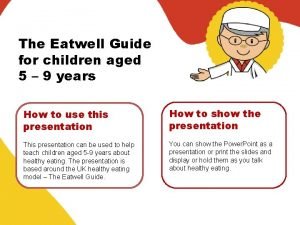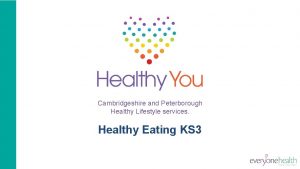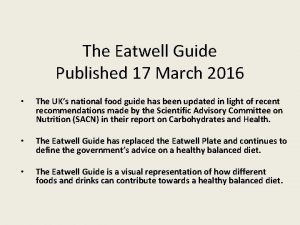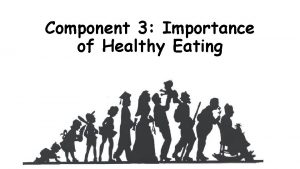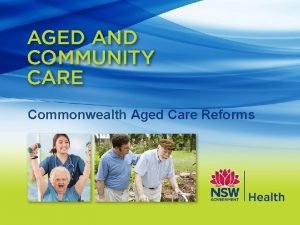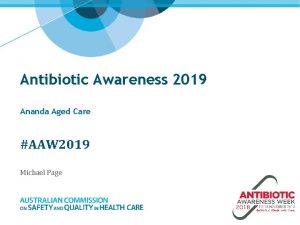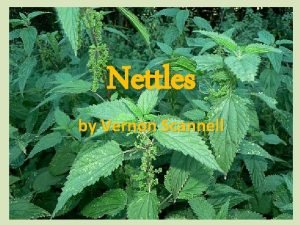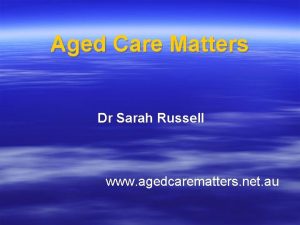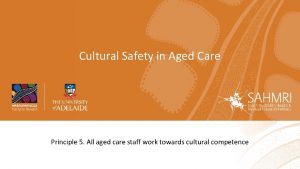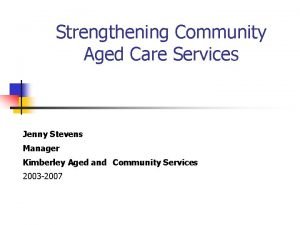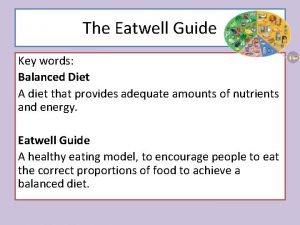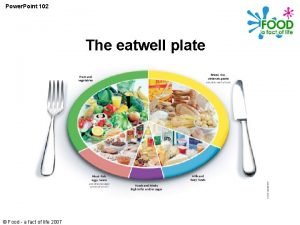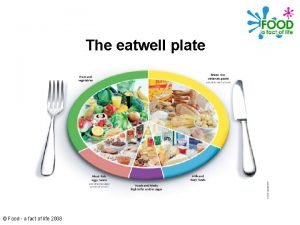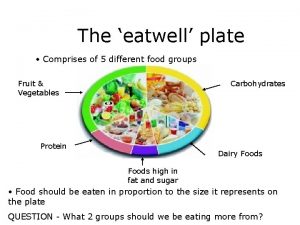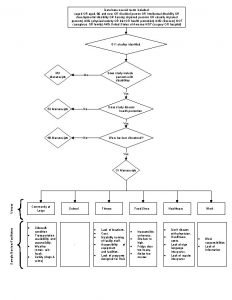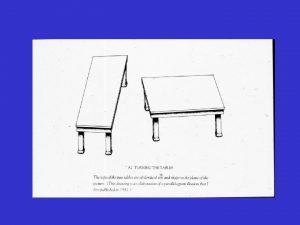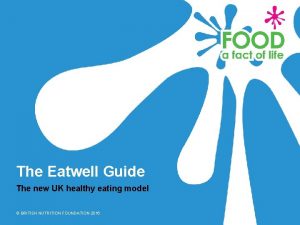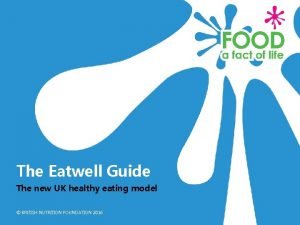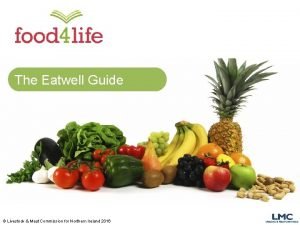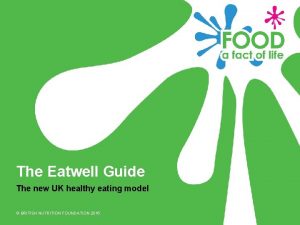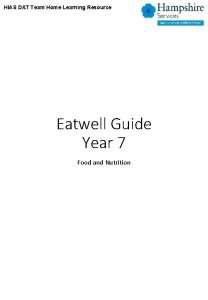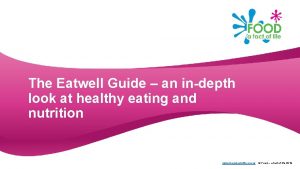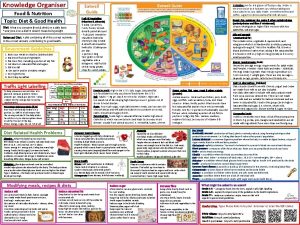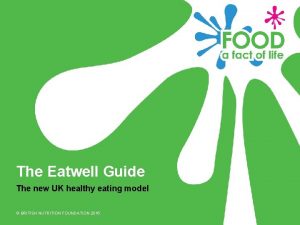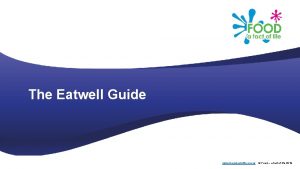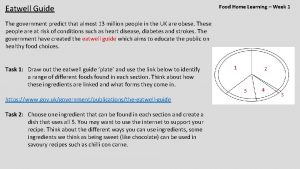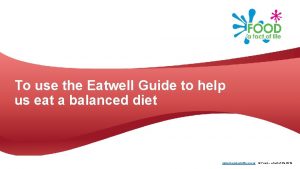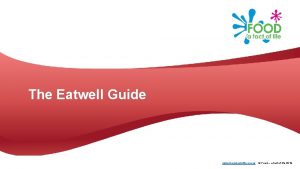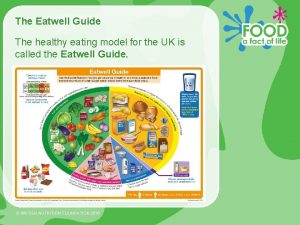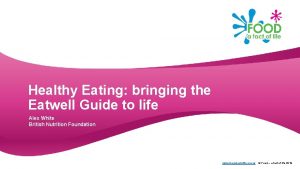The Eatwell Guide for children aged 9 11






















- Slides: 22

The Eatwell Guide for children aged 9 – 11 years How to use this presentation How to show the presentation This presentation can be used to help teach children aged 9 -11 years about healthy eating. The presentation is based around the UK healthy eating model – the Eatwell Guide. You can show the Power. Point as a presentation or print the slides and display or hold them as you talk about healthy eating. Note: This presentation is more detailed than the 5 – 9 years version. It contains additional information about the food groups, such as the nutrients and fibre. If you need a simpler Eatwell Guide presentation, feel free to use the 5 -9 years version.

The Eatwell Guide

How many food groups can you see? The Eatwell Guide Fruit and vegetables Beans, pulses, fish, eggs, meat and other proteins Potatoes, bread, rice, pasta and other starchy carbohydrates Dairy and alternatives

Fruit and vegetables What foods can you see? Eat at least 5 portions every day.

Potatoes, bread, rice, pasta and other starchy carbohydrates Eat a food from this group at every meal time. Try wholegrain varieties. What foods can you see?

Beans, pluses, fish, eggs, meat and other proteins What foods can you see? Eat some foods from this group every day, e. g. beans on toast and tuna pasta.

Dairy and alternatives Have some of these foods every day, e. g. a pot of yogurt and a cheese sandwich. What foods can you see?

Oil and spreads Eat in small amounts What foods can you see?

Foods high in fat, salt and sugars What foods can you see? If eaten, have less often and in small amounts.

Drinks 6 -8 a day Water and lower fat milk are healthier drink choices! You can have 150 ml of juice or smoothie a day.

What do you notice about the size of the groups? The Eatwell Guide Fruit and vegetables Beans, pulses, fish, eggs, meat and other proteins Potatoes, bread, rice, pasta and other starchy carbohydrates Dairy and alternatives

Which food groups are in this meal? Breakfast Grilled bacon, poached eggs, wholemeal toast, grilled tomatoes. Food groups • Fruit and vegetables • Potatoes, bread, rice, pasta and other starchy carbohydrates • Beans, pulses, fish, eggs, meat and other proteins • Dairy and alternatives • Oils and spreads

Which food groups are in this meal? Lunchbox Ham and salad sandwich, orange, chocolate mousse. Food groups • Fruit and vegetables • Potatoes, bread, rice, pasta and other starchy carbohydrates • Beans, pulses, fish, eggs, meat and other proteins • Dairy and alternatives • Oils and spreads How would you make it healthier?

Nutrients

Nutrients What are the main nutrients provided by the five food groups? Potatoes, bread, rice, pasta and other starchy carbohydrates Fruit and vegetables Beans, pulses, fish, eggs, meat and other proteins Dairy and alternatives What does each nutrient do?

Fruit and vegetables Vitamins, e. g. vitamin C. Vitamins are needed for good health. Vitamin C helps keep the cells in our body healthy and helps wounds heal.

Potatoes, bread, rice, pasta and other starchy carbohydrates Carbohydrate provides energy.

Beans, pluses, fish, eggs, meat and other proteins Protein is needed for growth and repair of muscles.

Dairy and alternatives Minerals are needed for good health. Calcium helps build strong bones and teeth. Minerals, e. g. calcium

Oil and spreads Fat is needed for general good health and helping us absorb some vitamins. Fat

Fibre is not a nutrient but is important for health. Fibre is needed to keep food moving through the body so the digestive system stays healthy. We can get fibre from… Wholegrain foods Fruit and vegetables

© Warburtons 2016
 Eatwell guide kids
Eatwell guide kids Eatwell guide quiz
Eatwell guide quiz Eatwell guide
Eatwell guide British nutrition foundation eatwell guide
British nutrition foundation eatwell guide Eatwell guide 2016
Eatwell guide 2016 What is the eatwell guide used for
What is the eatwell guide used for My aged care
My aged care Ananda aged care
Ananda aged care Nettles by vernon scannell analysis
Nettles by vernon scannell analysis Colors in the great gatsby
Colors in the great gatsby Aged care matters
Aged care matters Dignity of risk meaning
Dignity of risk meaning Open disclosure in aged care
Open disclosure in aged care Cultural safety in aged care
Cultural safety in aged care What is cultural safety in aged care
What is cultural safety in aged care Kimberley aged care services
Kimberley aged care services Nettles by vernon scannell
Nettles by vernon scannell The eatwell challenge
The eatwell challenge Eatwell plat
Eatwell plat Eatwell plate facts
Eatwell plate facts Eatwell plate definition
Eatwell plate definition Tack för att ni har lyssnat
Tack för att ni har lyssnat Varians
Varians
